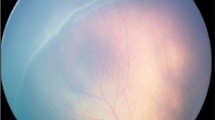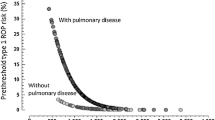Abstract
Purpose
To investigate the association of hepatic and renal parameters with the development of retinopathy of prematurity (ROP) in premature infants with a gestational age ≤ 32 weeks.
Methods
Medical records of 240 preterm infants were reviewed retrospectively, 85 of them were grouped as type 1, type 2 ROP, and control group. The 4th week hepatic and renal function test results of the groups, on the day of their first ROP examinations, were compared for the risk of development of ROP and the development of type 1 ROP.
Results
In this study, 12, 35, and 38 infants were enrolled in the type 1, type 2 ROP, and control group, respectively. The average gestational age and birth weight were higher; however, the duration of oxygen treatment was lower in the control group (p < 0.001). The blood glucose level was significantly higher in the type 1 ROP group than in the other groups (p = 0.023). The mean of total serum bilirubin of the type 1 ROP group was significantly lower than those of the type 2 ROP and control group (p = 0.032). Proteinuria was present in 85.7% of preterms with treatment-requiring ROP and proteinuria increased the risk of ROP by 3.9 times (OR with 95% CI 3.9 (1.19–12.75), p = 0.042).
Conclusion
We found significantly higher blood glucose and lower total bilirubin level in the type 1 ROP group. Moreover, our findings suggest that proteinuria may not be only a comorbidity factor but also related to a higher frequency of ROP and type 1 ROP in preterm infants.

Similar content being viewed by others
References
Blencowe H, Lawn JE, Vazquez T et al (2013) Preterm-associated visual impairment and estimates of retinopathy of prematurity at regional and global levels for 2010. Pediatr Res 74:35–49
Darlow BA, Gilbert C (2019) Retinopathy of prematurity - a world update. Semin Perinatol 43:315–316
Kim SJ, Port AD, Swan R, Campbell JP, Chan RVP, Chiang MF (2018) Retinopathy of prematurity: a review of risk factors and their clinical significance. Surv Ophthalmol 63(5):618–637
Tripolino C, Irace C, Carallo C et al (2015) Blood urea impairs brachial artery flow mediated dilation. Int Angiol 34:392–397
D’Apolito M, Du X, Pisanelli D et al (2015) Urea-induced ROS cause endothelial dysfunction in chronic renal failure. Atherosclerosis 239:393–400
D’Apolito M, Colia AL, Manca E et al (2018) Urea memory: transient cell exposure to urea causes persistent mitochondrial ROS production and endothelial dysfunction. Toxins 10(10):410
Gaton DD, Gold J, Axer-Siegel R et al (1991) Evaluation of bilirubin as possible protective factor in the prevention of retinopathy of prematurity. Br J Ophthalmol 75:532–534
Milner JD, Aly HZ, Ward LB et al (2003) Does elevated peak bilirubin protect from retinopathy of prematurity in very low birth weight infants? J Perinatol 23:208–211
Weintraub Z, Carmi N, Elouti H, Rumelt S (2011) The association between stage 3 or higher retinopathy of prematurity and other disorders of prematurity. Can J Ophthalmol 46(5):419–424
Kao JS, Dawson JD, Murray JC et al (2011) Possible roles of bilirubin and breast milk in protection against retinopathy of prematurity. Acta Paediatr 100:347–351
Fereshtehnejad SM, Poorsattar Bejeh Mir K, Poorsattar Bejeh Mir A, Mohagheghi P (2012) Evaluation of the possible antioxidative role of bilirubin protecting from free radical related illnesses in neonates. Acta Med Iran 50(3):153–163
Slidsborg C, Jensen LB, Rasmussen SC et al (2018) Early postnatal hyperglycaemia is a risk factor for treatment-demanding retinopathy of prematurity. Br J Ophthalmol 102:14–18
Lei C, Duan J, Ge G, Zhang M (2021) Association between neonatal hyperglycemia and retinopathy of prematurity: a meta-analysis. Eur J Pediatr 180(12):3433–3442
Good WV, Early Treatment for Retinopathy of Prematurity Cooperative Group (2004) Final results of the early treatment for retinopathy of prematurity (ETROP) randomized trial. Trans Am Ophthalmol Soc 102:233–48.
Chiang MF, Quinn GE, Fielder AR et al (2021) International classification of retinopathy of prematurity. Third Ed Ophthalmol 128(10):51–68
Berrocal AM, Fan KC, Al-Khersan H, Negron CI, Murray T (2022) Retinopathy of prematurity: advances in the screening and treatment of retinopathy of prematurity using a single center approach. Am J Ophthalmol 233:189–215
Higgins RD (2019) Oxygen saturation and retinopathy of prematurity. Clin Perinatol 46(3):593–599
Sangla A, Kandasamy Y (2021) Effects of prematurity on long-term renal health: a systematic review. BMJ Open 11(8):e047770
Hoogenboom LA, Wolfs TGAM, Hütten MC, Peutz-Kootstra CJ, Schreuder MF (2021) Prematurity, perinatal inflammatory stress, and the predisposition to develop chronic kidney disease beyond oligonephropathy. Pediatr Nephrol 36(7):1673–1681
Hayashi A, Santo Y, Satomura K (2014) Proteinuria and glomerular hypertrophy in extremely low-birthweight children. Pediatr Int 56(6):860–864
Rodriguez MM, Gómez AH, Abitbol CL et al (2004) Histomorphometric analysis of postnatal glomerulogenesis in extremely preterm infants. Pediatr Dev Pathol 7(1):17–25
Faa G, Gerosa C, Fanni D et al (2010) Marked inter individual variability in renal maturation of preterm infants: lessons from autopsy. J Matern Fetal Neonatal Med 23:129–133
Lembo C, Buonocore G, Perrone S (2021) Oxidative stress in preterm newborns. Antioxidants 10:1672
Perrone S, Mussap M, Longini M et al (2007) Oxidative kidney damage in preterm newborns during perinatal period. Clin Biochem 40(9–10):656–660
Graziosi A, Perrotta M, Russo D et al (2020) Oxidative stress markers and the retinopathy of prematurity. J Clin Med 9(9):2711
Müller-Deile J, Schröder P, Beverly-Staggs L et al (2018) Overexpression of preeclampsia induced microRNA-26a-5p leads to proteinuria in zebrafish. Sci Rep 8(1):3621
Mitanchez-Mokhtari D, Lahlou N, Kieffer F et al (2004) Both relative insulin resistance and defective islet beta-cell processing of proinsulin are responsible for transient hyperglycemia in extremely preterm infants. Pediatrics 113:537–541
Brooks SE, Gu X, Kaufmann PM et al (1998) Modulation of VEGF production by pH and glucose in retinal Muller cells. Curr Eye Res 17:875–882
Sone H, Kawakami Y, Okuda Y et al (1996) Vascular endothelial growth factor is induced by long-term high glucose concentration and up-regulated by acute glucose deprivation in cultured bovine retinal pigmented epithelial cells. Biochem Biophys Res Commun 221(1):193–198
Au SC, Tang SM, Rong SS, Chen LJ, Yam JC (2015) Association between hyperglycemia and retinopathy of prematurity: a systemic review and meta-analysis. Sci Rep 5:9091
Baranano DE, Rao M, Ferris CD, Snyder SH (2002) Biliverdin reductase: a major physiologic cytoprotectant. Proc Natl Acad Sci U S A 99(25):16093–16098
Acknowledgements
This study was presented as a free paper at the 51st National Congress of the Turkish Ophthalmological Association.
Funding
None.
Author information
Authors and Affiliations
Contributions
Study design was made by Ayse Ipek Akyuz Unsal and Buket Demirci, Material preparation and data collection were made by Ozge Key, Duygu Guler, Imran Kurt Omurlu did a statistical analysis of the study and prepared the figure, Seyhan B. Özkan, Munevver Kaynak Turkmen, Ayse Ipek Akyuz Unsal and Buket Demirci, Sayime Aydin Eroglu were supervisor of the study, Sayime Aydin Eroglu and Ayse Ipek Akyuz Unsal wrote the main manuscript and prepared the tables, All authors reviewed the manuscript.
Corresponding author
Ethics declarations
Conflict of interest
Author declares no potential conflicts of interest with respect to the research, authorship, and/or publication of this article.
Ethical approval
Approved by the following research ethics committee: Aydin Adnan Menderes University Ethical Committee and Review Board (code and decision number: 2016/901; 26.05.2016/13).
Additional information
Publisher's Note
Springer Nature remains neutral with regard to jurisdictional claims in published maps and institutional affiliations.
Munevver Kaynak Turkmen: Retired.
Rights and permissions
Springer Nature or its licensor holds exclusive rights to this article under a publishing agreement with the author(s) or other rightsholder(s); author self-archiving of the accepted manuscript version of this article is solely governed by the terms of such publishing agreement and applicable law.
About this article
Cite this article
Eroglu, S.A., Unsal, A.I.A., Abdullayev, O.K. et al. The role of hepatic and renal functions in the development of retinopathy of prematurity: Is proteinuria a new risk factor?. Int Ophthalmol 43, 483–490 (2023). https://doi.org/10.1007/s10792-022-02445-9
Received:
Accepted:
Published:
Issue Date:
DOI: https://doi.org/10.1007/s10792-022-02445-9




